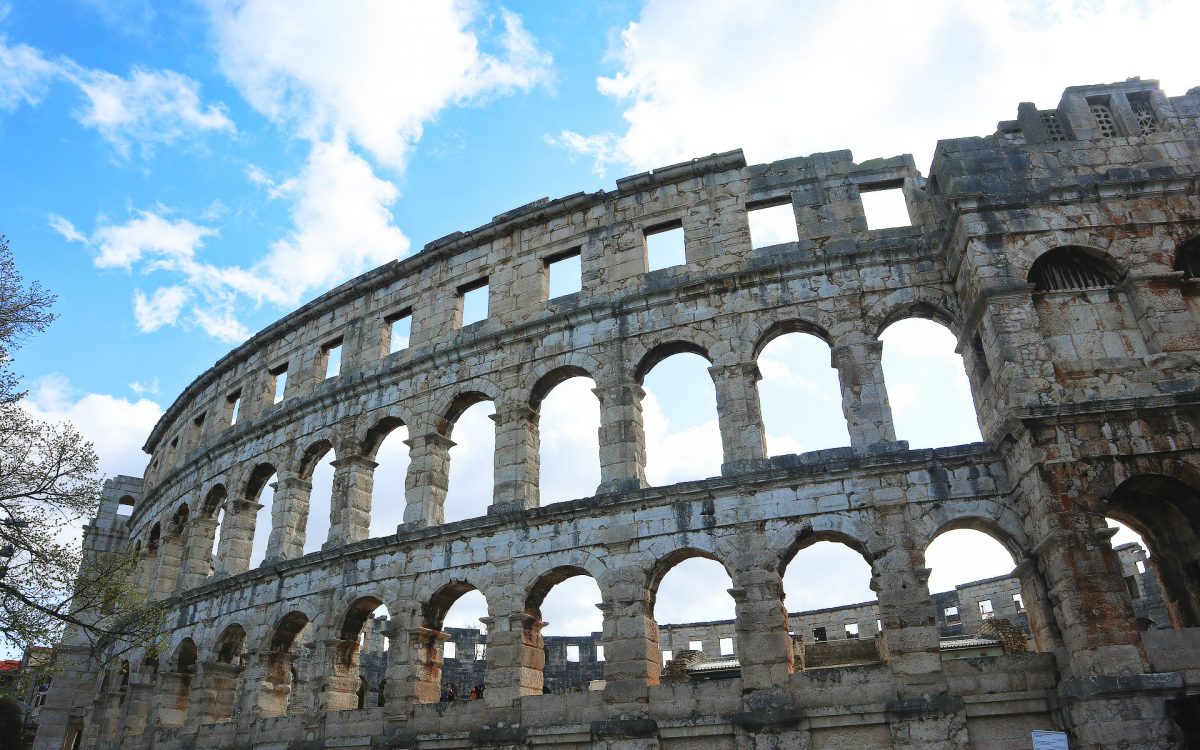Istria is the biggest peninsula of the northern adriatic sea and has a size of approx. 3.500 km². It is shared by the three countries Croatia, Slovenia and Italy, but I concentrate on the croatian part in this article.
The name is derived from the Histri (Greek: Ἱστρών έθνος) tribes that Strabo has told were living here. They were credited as the ones that created the hillfort settlements also called castellieri.
Short History
The romans needed some effort to finally conquer them around 177 BC and then referred of the area as “Venetia et Histria”.
After the Roman Empire, the are was also reigned by the dukes of Carantania, Merania, Bavaria and by the patriarch of Aquileia, before it became a part of the Republic of Venice in 1267.
After that it was reigned by the Habsburg Monarchy (1797–1805), followed by the Napoleonic Era (1805–1814), the Austrian Empire (1814–1918), Italy (1919–1947), then the SFR Yugoslavia (1947–1991) and lateron to the Republic of Croatia.
Explore Istria
As there are no major airports in Istria, you hopefully have the opportunity to visit Istria by car, which is my recommended form of transportation for this area of Croatia, because getting around by bus or bike is possible, but time consuming and there is such a massive number of beautiful things to see, that you definitely have to go there by car.You can find my most recommended places-to-see in the integrated Google Map here, that you can also use for navigation by car or even in the cities itself when walking.
Istria itself has a large variety of beautiful beaches, amazing hilltop towns, a lot of art spots, great opportunities for sports and also beautiful archeological places.
Oh…and not to forget the food! Sea food is absolutely amazing here and there is also a large variety of meat dishes, pizza and pasta offered that you should try out. If you’re having an appartment for your stay, be sure to buy bread and sweet stuff at a local bakery. My personal favourite are sausages in bread dough and the sweet Kremšnite. Soooo good!
Have fun exploring!
Must-see spots in Istria
There is so much to see in Istria/Croatia, no matter if you’re interested in cultural, archeological or nature spots. I have gathered my most recommended ones here including some closer informations on the spots.
Grožnjan
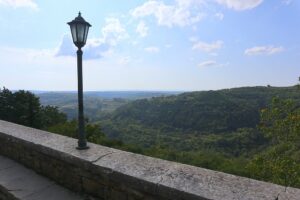 Grožnjan was first mentioned in 1102 to be in the ownership of the Patriarchs of Aquileia and was expanded by the Venetians from 1358 on as an important military outpost. With the downfall of the venetian reign in 1779 the city was becoming more and more unimportant.
Grožnjan was first mentioned in 1102 to be in the ownership of the Patriarchs of Aquileia and was expanded by the Venetians from 1358 on as an important military outpost. With the downfall of the venetian reign in 1779 the city was becoming more and more unimportant.
After the second World War it belonged to the “Free Territory Triest” and therefore lost more and more citizens until it was almost empty and even lost the town state and was administrated from Buje between 1956 to 1993.
Famous was the small town for it’s light coloured marble stone (Grisignia-Marmor) that was used in architecture in Vienna, Triest and Budapest. Also the old town of Grožnjan shows a lot of this marble in it’s architecture.
In 1965 the artist and sculptor Aleksandar Rukavina got the permission for around 30 artists to use the decaying buildings for free. They committed themselves for this to keep the old buildings and the town in shape.
Today the small hilltop town is a beautiful mixture of artists with their galleries (paintings, sculpting, glas art and more), some small cafés and restaurants where you can relax, find beautiful art and enjoy the wonderful old streets and architecture.
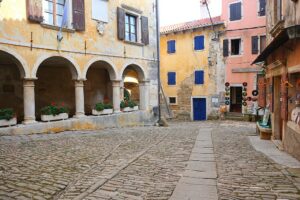 Sightseeing spots are the catholic church of St. Vitus, Modestus and Cresentia, which was built in 1770 on the remains of an older church from the 14th century. It’s bell tower was build before in 1721.
Sightseeing spots are the catholic church of St. Vitus, Modestus and Cresentia, which was built in 1770 on the remains of an older church from the 14th century. It’s bell tower was build before in 1721.
The Kastel right beneath the church was the home of the venetian majors and was first mentioned in 1102.
Right beneath it the old town gate built during the 15th century still shows the family coat of arms of the venetian city administrator.
The former grain store built in 1597 is now famous to be the arts gallery “Gallery Fonticus” and shows works of national and international artists.
The event highlight of the year is the yearly artist meeting “Ex Tempore”.
Novigrad
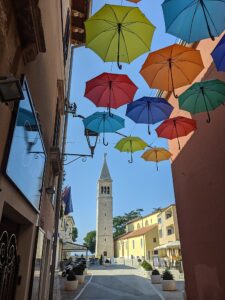 The beautiful small town of Novigrad, which is still also called by it’s italian name “Cittanova” is located between Umag and Porec. It’s roots are going back to ancient times and when greek seamen already had a first settlement here. The leftovers of this time are nowadays under the sea level.
The beautiful small town of Novigrad, which is still also called by it’s italian name “Cittanova” is located between Umag and Porec. It’s roots are going back to ancient times and when greek seamen already had a first settlement here. The leftovers of this time are nowadays under the sea level.
Archeologists assume that during roman times a roman villa was on the island that today forms the old town. The small settlement Civitas Novum was built around it, which is also the source of the italian name Cittanova.
After the downfall of the roman empire around 476, the city was part of the bycantine empire and during the 5th century it was ruled by the Ostrogoths.
During the 6th century roman refugees settled here and named it Emonia and during that time it is also mentioned in historic documents to have bishops located in Novigrad.
The city went through a lot of ownerships until the Venetians take over the city in 1270 and reign until around 1779. The city is tortured by Malaria and the Plague during the 16th and 17th century and the citizens left in the now called Neapolis mostly live in the old dilapidated buildings.
With the beginning of the 18th century the city rises again when venetian investors build new houses that still exist in the old part of the town. It was during that time, that the island was finally connected to the shore and created the city plan that exists nowadays, so the city transformed from a island to a peninsula.
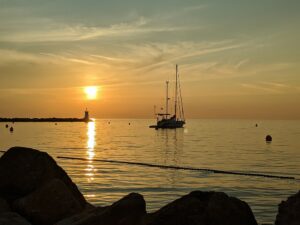 Through the french, austrian and german times of the city that followed it nowadays is a small, beautiful city with around 5.000 citizens and many beautiful places to visit.
Through the french, austrian and german times of the city that followed it nowadays is a small, beautiful city with around 5.000 citizens and many beautiful places to visit.
Especially the walk around the peninsula with it’s beautifully preserved town walls (13th century), the church of St. Pelagius and the museums “Lapidarium” & “Gallerion” are worth a visit.
Having dinner at one of the restaurants rewards you with beatiful views, very tasty croatian food and especially during off-season you can enjoy the original mood of a small istrian city. End your day at one of the cocktail bars at the harbour of Novigrad and you will never want to be somewhere else.
Pula
Pula (German/Italian: Pola; Slovenian: Pulj; Greek: Πόλαι Pólai; Latin: Colonia Pietas Iulia Pola Pollentia Herculanea) is the biggest city of Istria and it’s metropolitan area has around 90.000 residents.
It is most known and famous for it’s various roman architectural gems and has one of the best preserved roman amphitheaters in the world. It was also the administrative center of istria since ancient roman times until this moved over to Pazin in 1991.
The city has a very long tradition of wine making, fishing, ship building and in more present days quite a lot of tourism.
Roman Amphitheater
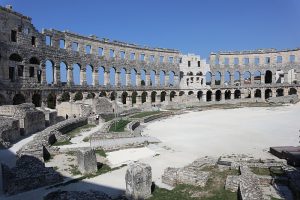 The Pula Arena is the name of the amphitheater located in Pula. Constructed mostly of limestone it’s building time was from 27 B.C. to 68 A.D., has an eliptical form with 132.45 to 105.10 metres and is 32.45 metres high at it’s highest point.
The Pula Arena is the name of the amphitheater located in Pula. Constructed mostly of limestone it’s building time was from 27 B.C. to 68 A.D., has an eliptical form with 132.45 to 105.10 metres and is 32.45 metres high at it’s highest point.
The Arena was able to house up to 26.000 spectators and had a total of 15 gates. Underground passages were built under the arena from which animals, ludi scenes and fighters could enter the main area and stores and shops were located under the seating area. The amphitheatre was also part of the tour of the gladiators.
The first wooden built amphitheater was built in Pula under Emperor Augustus. Some centuries later the arena was converted to a solid stone built architecture, but Emperor Vespasian is responsible for the amphitheater we can see nowadays. The emperror wasn’t able to see the arena’s opening, because he died too soon, so the opening was finally in 80 A.D. celebrated under Emperor Titus.
How advanced these architectures were, can be seen by the features, the amphitheater already had back then. Four water tanks were installed in the chair towers that collected the rain and then also perfumes were added to the water. It as used to sprinkle water onto the spectator’s area on hot days.
The arena could be covered with velaria (large sails), protecting the spectators from sun or rain. The 70 holes that were used for the machanics of the roof are still visible today.
After the fall of the Roman Empire, the amphitheater wasn’t used anymore and for along time the arena was used as source for building material until this was prohibited in 1260 and again in 1458. A lot of the inner buildings were gone by then, but when there were the first archeological interest and diggings in he 18th and 19th century, quite a lot was rebuilt to the arena we see today.
If you search for a piece of architecture where you can actually “feel the history”, the Pula Arena is the place to be! Amazing!
Historic and Maritime Museum
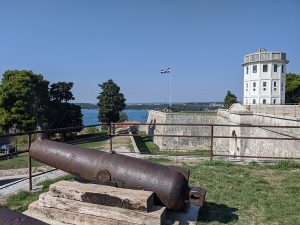 The Historical and Maritime Museum of Istria is located on Kaštel, the central Pula hilltop that is approximately 34 metres above sea level. It is housed by a historical venetian fortress designed by the French military engineer Antoine De Ville. The construction of the fortress started in 1630 on the ruins of a medieval castle and was finished in 1633. The fortress also was built above the Nimfeia, which is an abundant freshwater spring which has been used since antiquity. At that time it was architectonically one of the most important and monumental buildings of the Venetian Republic.
The Historical and Maritime Museum of Istria is located on Kaštel, the central Pula hilltop that is approximately 34 metres above sea level. It is housed by a historical venetian fortress designed by the French military engineer Antoine De Ville. The construction of the fortress started in 1630 on the ruins of a medieval castle and was finished in 1633. The fortress also was built above the Nimfeia, which is an abundant freshwater spring which has been used since antiquity. At that time it was architectonically one of the most important and monumental buildings of the Venetian Republic.
With the conclusion of the Thrity Years War in 1648 the fortress lost it’s importance and the works on the structure were stopped, until the Austrian army arrived in 1813 and brought new life into the architectural gem. They changed the inner buildings quite heavily and the Austrians also built the fortress’ first water cistern that lateron also was one part of the modern water supply system of Pula. The fortress was known as Hafenkastell during that time.
With the dissolution of the Austro-Hungarian Monarchy the forttress lost it’s defensive function and was lateron used as a communication and and observation point by the Italian military until it was used as Yugoslav Army facility during the Second World War.
In the early 1960ies it was changed to house the Historical and Maritime Museum of Istria that displays some permanent and some occasional exhibitions.
From the walls of the fortress you can enjoy a beautiful view over the city, the bay area and the surrounding suburbs including the Arena of Pula.
Temple of Augustus
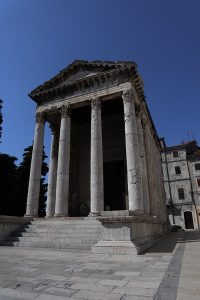 The Temple of Augustus (Croatian: Augustov hram) is one of the best preserved Roman temple outside of Italy. It is dedicated to the first Roman emperor: Augustus. It was built between 27 B.C. to 14 A.D during the lifetime of the Emperor Augustus.
The Temple of Augustus (Croatian: Augustov hram) is one of the best preserved Roman temple outside of Italy. It is dedicated to the first Roman emperor: Augustus. It was built between 27 B.C. to 14 A.D during the lifetime of the Emperor Augustus.
It has been built on a podium with Corinthian columns and is approx. 8 by 17.3 metres large and 14 metres high.
The remaining temple on the forum of Pula is one of originally three temples at this place. The largest one was in the middle, while the Temple of Augustus and the Temple of Diana were on it’s sides. Remains of the backside of the Temple of Diana are incorporaten into the communal palace, that has been built in 1296.
If the temples has still been in use by the 4th-century, it surely has been closed during the persecution of pagans in the late Roman Empire. During the Byzantine times, it has been converted into a church and lateron it was used as a granary.
DUring the Allied air raid in 1944 it has been hit by a bomb and got almost completely destroyed, but was reconstructed in 1947 with the remaining original parts.
Nowadays it is used as a lapidarium to display a small but important collection of Roman sculptures.
Small Roman Theater
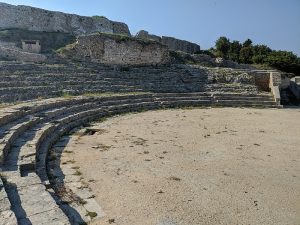 The small Roman Theater that can be seen was already located within the city walls during the old times. It is located right beneach the Kastel of Pula and the most easy way to reach it is to go around the outer fortress wall around the Kastel.
The small Roman Theater that can be seen was already located within the city walls during the old times. It is located right beneach the Kastel of Pula and the most easy way to reach it is to go around the outer fortress wall around the Kastel.
This theater was built in the 1th century A.D. and the theater’s area was divided into the stage where the acting was shown, the orchestra and the cavea, which is the spectator’s area.
The theatre is located on the hill slope, which was the characteristic of Greek an Roman theatres and it’s capacity was estimated between 4 and 5 thousand spectators, which was the entire population of Pula at the time. Unfortunately only the stage foundations and parts of the semi-circular viewing area, aswell as an beautiful entry arch with stairs to the viewer’s area of the Small Roman Theatre are preserved nowadays.
During the Antiquity, the area the theatre occupied was a lot larger, but this is not visible today and the archaeological surveys in this part were never completed unfortunately. This also explains the difference between what can be seen today and the original state that is visible today.
Unfortunately this small theater is decaying more and more. The spectator’s seats are carved directly out of the stone which is one of the problems, because the stone formations there tend to break during winter. If you go there, please be sure to wear closed shoes as there may be broken glass on the paths.
Nevertheless the preservation state of this site isn’t too good, I really like the small Roman Theater because of it’s historic importance. I really hope this will be cleaned and presented more beautiful in the future some day.
Dvigrad (Kanfanar)
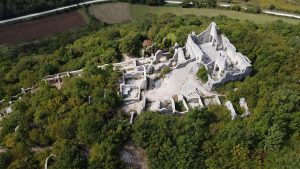 Dvigrad, which means “Twin-Castles” (Italian: Due Castelli, Istriot: Docastei), is an abandoned medieval town which is located in the Draga valley.
Dvigrad, which means “Twin-Castles” (Italian: Due Castelli, Istriot: Docastei), is an abandoned medieval town which is located in the Draga valley.
I also made a video with some impressions of Dvigrad.
The ruins that can be seen were built on the leftovers of a prehistoric settlement of the Illyrians. Because of it’s strategic location is was an important economic center of the region.
The ruins are an important archeological location with a symbiosis of religious and everyday life buildings. The town developed out of two castles (Moncastello and Castello Parentino) that merged together and created a stronghold like town with around 1000 citizens. The town was, because of it’s strong walls and location, never conquered or destroyed.
During the 16. century, the plague and malaria killed most of the population of the town, that is said to have been closed down and by 1631 the inhabitants of this lovely town were dead. Other sources tell, that by 1650 three families were still living there, but also left the town around by 1714 the latest.
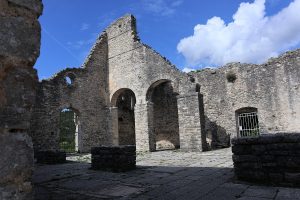 Nowadays the ruins of the town are under renovation and it is a very remarkable place to get a great impression on the infrastructure and size of a town of this age. The ruins of the Church of Saint Sofija isone of the best preserved ruins of the city and beautifully overlooks the town place right in front of it. The first church was an Early Christian single-nave structure, which was later partitioned into a three-nave hall church. The church area itself is closed, but can be looked into from the outside. It still has some graves in the floor and you can also get a good impression of the look of the church.
Nowadays the ruins of the town are under renovation and it is a very remarkable place to get a great impression on the infrastructure and size of a town of this age. The ruins of the Church of Saint Sofija isone of the best preserved ruins of the city and beautifully overlooks the town place right in front of it. The first church was an Early Christian single-nave structure, which was later partitioned into a three-nave hall church. The church area itself is closed, but can be looked into from the outside. It still has some graves in the floor and you can also get a good impression of the look of the church.
This place is simply beautiful and wandering around, especially when it is not crowded, rewards you with some peaceful and relaxing time. Nowadays there are some efforts of restoring and renovating the town and they make progress every year, which makes me happy, as this is one of my favourite places in Istria.
Also be sure to give the people running the small food stand a visit. They make delicious Palačinke with choclate or marmelade.

